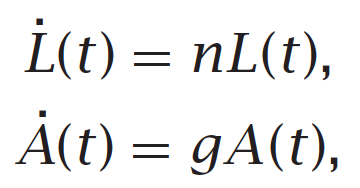Business/Economics FlashCards sobre Solow Model, criado por Greg Caskey em 18-10-2018.
Pin adicionado em
72
1
0
Sem etiquetas
|
|
Criado por Greg Caskey
aproximadamente 6 anos atrás
|
|
Fechar
|
|
Criado por Greg Caskey
aproximadamente 6 anos atrás
|
|

The Solow Model emphasizes that which factors of production are unimportant?
What are Kaldor's 6 stylized facts of growth?
In an exogenous growth model, growth is caused by:
Suppose that two countries share identical levels of total factor productivity, identical labor force growth rates and identical savings rates. Country A has greater initial level of output per worker than Country B. According to the Solow model, how will the two countries grow in terms of output per worker, all else constant?
T/F
The Solow Growth Model predicts that rich nations will grow faster than poor nations
T/F
If the central prediction of the Solow Growth Model is valid, Per capita Real GDP differences among nations will diminish.
If a war destroys a large portion of a country's capital stock but the saving rate is unchanged, the Solow model predicts output will grow and that the new steady state will:
In the Solow growth model, if investment exceeds depreciation, the capital stock will
______ and output will ______ until the steady state is attained.
AL is referred to as _________, and technological progress that enters in this fashion is known as labor-augmenting or
Harrod-neutral.
What are the implications of CRS in Solow's two arguments, capital and effective labor?
What is the CRS equation for Solow's two arguments, capital and effective labor?
Intensive form of
Solow production
function
How do we get to output per unit of effective labor as a function of
capital per unit of effective labor?
Namely, y= f(k)
ƒ'(k) = positive
ƒ''(k) = negative
what does this mean?
What are the implications of the Inada conditions for the Solow model?
What does the production function satisfying Inada conditions look like?
In other words, one that shows
ƒ'(k) = positive
&
ƒ''(k) = negative
How does the production function takes its intensive form?
What is the Solow production function expressed in Cobb-Douglas terms?
Illustrate that the Cobb-Douglas function
has CRS
Illustrate the intensive form of the production function:
What are the growth rates of
Labor and Knowledge?
With Cobb-Douglas, labor-augmenting, capital augmenting, and Hicks-neutral are essentially all the same.
What does these equations imply?

The growth rate of a variable equals the rate of change of its natural log.
Demonstrate this:
(Chain Rule, since ln X is a function of X, and X is a function of T)
Demonstrate that the rates of change of the logs of L and A are constant, and that they equal n and g, respectively.
In the Solow model, output is divided between ________ and _________.
What is the equation showing this?
What formula demonstrates the growth rate of K?
What are the distinctions between Solow, RCK, and Diamond regarding how output is divided between consumption and investment?
What are some ways in which Solow is grossly oversimplified?
How are we to regarding the savings rate in the Solow model?
How are we to regard the evolution dynamics of labor and knowledge?
Demonstate the dynamics of k
Demonstate the dynamics of k
(Cont'd)
What is an implication of the economy being closed in the Solow Model as it relates to savings/investment

Graph the dynamics of the economy
Graph the phase diagram for k in the Solow Model. What are the implications?
What is true in the Steady State (BGP) concerning each variable?
Use logs to prove the constant growth rates in the steady state by
differentiating with respect to time t
Demonstrate on a graph the effects of an increase in the saving rate on investment, k*, and the new steady state.
What two effects does an increase in the savings rate have on consumption ?
Demonstrate the impact of a change in s can be computed as follows
To demonstrate a change in s and the effect is has on c, differentiate the above expression with respect to s.
If an increase in the savings rate raises or lowers consumption in the
LONG RUN is dependent upon what?
Illustrate on a graph the
Golden-Rule Level of k

 Ocultar acertos
Ocultar acertos